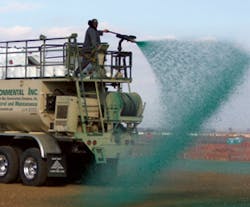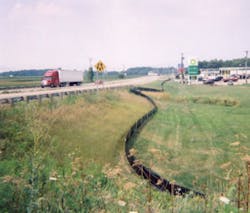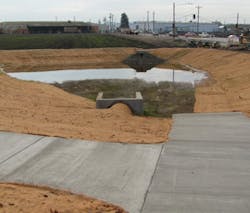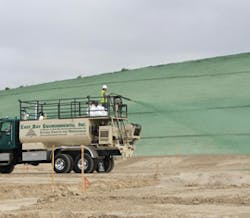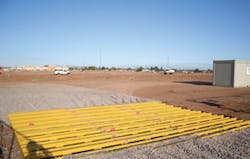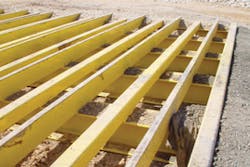To say the least, no one-size-fits-all erosion and sediment control solution for construction sites exists. Since 2003, when Phase II of the National Pollutant Discharge Elimination System (NPDES) took effect, the task of controlling erosion and sedimentation has become more of a challenge because contractors have had to formulate a plan, even for construction sites from 1 to 5 acres. NPDES permits require the inclusion of a stormwater pollution prevention plan (SWPPP) specifying what measures will be used. Because SWPPPs often rely on the use of best management practices (BMPs) that are accepted at the state level, several contractors indicate that there is room for ingenuity.
A wide array of tools and methods are available to contractors who face an increasingly strict atmosphere as SWPPPs are enforced under the watchful eye of regulators whose sophistication is growing. Three contractors share with Erosion Control the various tools and methods they use in their different geographic areas.
Recommending Improvements
Brian Tillman, director of environmental services for East Bay Construction in Livermore, CA, says that the local
A silt fence installer mounted on a four-wheel-drive tractor was used to install a long silt fence in northwest Ohio.
regulatory atmosphere allows him plenty of opportunity to apply ingenuity to the SWPPPs under which the company controls erosion and sedimentation. A landscaping company employing more than 300 people that expanded into erosion control services and brought in Tillman to head up its erosion control division five years ago, East Bay has recently opened an office in southern California and gotten heavily involved in public works projects as the housing market in California has slowed down. “Probably 95% of our work is public works jobs,” he says, adding that about 80% of the company’s projects were in the residential sector for many years. Tillman argues that he has some tools and techniques that are of benefit to local regulators who sometimes specify antiquated ones in SWPPPs.
“The people doing the SWPPPs-the items that they’re using are so outdated that you might have seen them on a plan 20 years ago,” he says. “I would say that maybe 90% of people who make the SWPPPs are using the same specs-they’re not keeping up with the times. There are so many products out there you can use that are cheaper for the customer and also a better BMP.”
An example of an outdated specified method, Tillman says, is the use of asphalt emulsion as a tackifier for straw on hydroseeded slopes. “You still get specs where they still want to put asphalt emulsion on top,” he says. “There are so many more tacking agents out there.”
That is not to suggest that enforcement of SWPPPs is lax in East Bay’s geographic market. “In northern California, the inspectors are definitely paying attention to what’s going on,” says Tillman. Elsewhere, he says, “you don’t have the enforcement that you have in northern California or even southern California. I understand that southern California’s really stepped up its efforts in the past two or three years.”
Experience serves as a valuable mentor when Tillman recommends a performance-based alteration to a SWPPP. “For most of the jobs I do in the private sector, I make suggestions and I’ll clarify them in my bid,” he says, adding that he often recommends specific alternative methods to a specified BMP. An admittedly extreme recent case of recommending changes to the SWPPP was on a hydroseeding project in the North Bay area, in which the plan called for the injection of asphalt emulsion into straw as it was being dispersed through a blower. “We know what asphalt emulsion is; we don’t think that’s adequate to be put in the environment,” Tillman says. “That’s a spec that’s at least 20 years old. That’s what’s in the spec instead of using a guar-style [tackifier] or Plantego-style tack.”
Coir mats installed around a detention pond
On the recent North Bay area project, East Bay used what Tillman describes as the company’s “triple step” for hydroseeding and tacking. “You apply seed, but basically [the] hydroseed won’t stand by itself under rainy conditions because you’re not using a [bonded fiber] matrix or HydroStraw,” he explains. “You blow straw on top of it and then blow it down with paper mulch and some type of binder. Basically, that takes the impact of the rain, so your hydroseed underneath will stay, and it creates a compost blanket on top. We don’t use [asphalt emulsion]; we use Plantego or guar. I suggested my own spec, and that’s the way I submitted it.”
Tillman reports that the eco-friendly binding agents that East Bay uses provide good tacking effectiveness. “You’ve just got to make sure you’ve got enough binder per acre to make it adequate and get enough coverage, or the straw will blow away,” he says.
Besides hydroseeding and eco-friendly tackifiers, the company does use a great deal of bonded fiber matrix, as well as wattles and silt fence, says Tillman. “Most of the time, wattles are used here for putting behind sidewalks, not letting any sediment get into the drain pan. There are a lot of different brands of wattles,” he notes, stressing that he quotes and installs a more expensive brand despite a relatively high price. “I know there’s other cheaper stuff out there, but you can take this wattle and install [it], and a year later, it’s still the same diameter-just a little bit of compaction or shrinkage. Or, you can use some competitor’s wattle, and a year later, it’s half the diameter. I’m competing against guys who are using the cheaper wattle, and I still continue to use the more expensive stuff.
“A lot of people I work with trust my judgment, so they believe it when I say that in the long term, it’s going to be a cost savings to use to use this wattle that might cost 20 cents a foot more than the other stuff because you’re not going to replace it in a year,” he continues. “Right now it’s a difficult situation-everybody’s trying to pinch pennies.”
Some of the other products and methods that Tillman describes are used for more permanent erosion control and are not used just during the construction phase. “We have a lot of sites where the slopes are permanent, and in other areas, the slopes aren’t yet permanent,” he says. “We’ll put hydroseed on one slope, and, across the street, there’s a slope that requires temporary seed. We’ll put temporary on it for now, and it suffices as a BMP for the winter, but next spring the general contractor blades all that compost off when it becomes a permanent slope, then we’ll go back and put the permanent seed down. Usually our permanent stuff is a BFM, and our temporary matrix is more of a triple step or HydroStraw, although HydroStraw is used for permanent slopes, too. As far as matting, a plastic mat that would work for years and years, versus a coconut or straw mat where the lifespan could be one or two years.”
Maintenance, not just the products used, is important to the effectiveness of erosion and sediment control measures, Tillman argues. “All wattles work; the key is to make sure that all of the area is protected so nothing gets into the drain pan and ends up in the storm drain. The biggest thing is to maintain, maintain, maintain. It might seem like a lot of money, but the penalties are a lot higher than it costs to maintain. Especially if they go on grading through the rainy season, you’ve got to get right behind the contractor with soil stabilization methods.”
Efficient Silt-Fence Installation
Brent Grassbaugh, head of erosion control for Complete General in Columbus, OH, reports that in his area,
Complete General uses a significant volume of silt fence and installs it quickly and precisely with the Edge attachment, here shown being deployed by a skid-steer loader. The contractor actually uses a four-wheel-drive tractor for this task.
regulators respect the construction contractor’s expertise in terms of using performance-based erosion control methods. Contractors often make recommendations for changes to SWPPPs. Complete General works mainly within Ohio and specializes in bridge work, road work, utility work, and electrical work. “[Field inspectors] often suggest that we use straw wattles in place of silt fence and tell us that we can also improvise, and it keeps them happy,” says Grassbaugh, who worked on utility projects for more than 30 years before focusing on erosion control. “On our SWPPPs, as long as I highlight where I’ve installed something, everything’s pretty relaxed.”
Grassbaugh says that Complete General uses a high volume of silt fence for erosion control during the construction phase. “If you have a live creek running through the site, you’ve got to keep an eye on your silt fence after the rains and make sure you don’t have any spillage,” he says. “Sometimes I double and triple it just to make sure I’m covered, because it doesn’t cost that much to put it up, compared to a fine.”
In the past couple of years, Grassbaugh has experienced a major leap in silt fence installation productivity by mounting an Edge silt fence installer from CEAttachments on a four-wheel-drive tractor. The pivoting unit allows the tractor operator to install silt fence around tight corners. The installer is equipped with a folding chute for the silt fence and an adjustable fabric roller that accommodates roll diameters of 36, 42, and 48 inches. A spring-loaded coulter cuts through trash and turf during installation. “It’s got a little gate in the back, and you just thread your silt fence through the gate while somebody stands on the end of the silt fence,” says Grassbaugh. “As the tractor buries the attachment and pulls away, the silt fence begins burying itself. It’s got something like a rock tooth for a backhoe on it. It just plows it in and follows you wherever you go. Once you learn how to maneuver it, you can go around corners, around poles, lines-you can go around trees and everything.”
Precision is also important to Grassbaugh when it comes to installing silt fence. “I’m very meticulous-it doesn’t matter if I’m putting silt fence in or doing something else,” he says. “My garage is cleaner than most people’s houses.”
One recent project-installing silt fence for erosion control during ramp work and widening of an intersecting road along State Route 127 in northwest Ohio-relied heavily on the silt fence installer for precise placement of long silt fence runs of 1,000 feet or more. “The slope was 4:1, and I’d say it was probably 100 feet from top to bottom,” Grassbaugh reports. “The silt fence did what it was designed to do. It held back the silt and even rocks. It’s nice when you’re done and look behind you and see that it has been done right. I know it doesn’t mean anything to some people, but when it’s straight and tight, I know the silt fence will hold and not pull out. I even set an end post and tied it just to make sure it stayed tight.”
Grassbaugh, who grew up on a farm and learned how to drive tractors at a young age, adds that the learning curve for the Edge is reasonably short. “Just going around corners, turning sooner-you just have to learn that on your own. We had a hard time at first because our tractor tires weren’t loaded, and you’d spin the tires. We had to get our tires loaded on our tractor; once we got that done, it simplified everything.”
Preventing Desert Dust
One form of sediment control is preventing the tracking of mud and dirt onto the roads and streets bordering a construction site. Measures to prevent this problem are particularly critical in the hot, dry Southwest, explains Jim Currie, senior project superintendent with Kichell Corporation in Phoenix, a general contractor focusing mainly on institutional and commercial work west of the Mississippi.
Stabilizing slopes and building pads with HydroStraw
“Any kind of trackout that gets out into a street and creates dust causes a problem,” Currie points out. “Obviously, out here in Arizona, we get 360-odd days of sunshine a year and warm temperatures, so dust becomes an issue. Trackout is a problem because we have to use water to eliminate dust onsite from construction-site movement. Also, with the soil we have-a lot of clay, a lot of clinging soils-you end up picking that up on the vehicles that leave the construction site. The mud gets tracked out onto the main streets, and it leaves mud and that becomes dust in the air.
“The way these regulatory agencies work out here is they’ll follow tracks back to your site, and that’s what they use for their proof and citations.”
Currie adds that the local regulatory atmosphere has become more aggressive during the past few years-both in regard to the state and county. “Right now, the Arizona Department of Environmental Quality is very active. We also have another agency, the Maricopa County Air Quality Department-they’re both very active.”
To address the trackout problem, Kichell uses Grizzly devices from Trackout Control LLC. The devices are basically steel grates that generate significant wheel vibration as construction trucks and equipment drive over them. The vibration shakes material from the wheels, undercarriage, and chassis of the trucks and equipment into the freeboard space below the device. The standard widths are 10 and 20 feet, but the manufacturer can also provide custom widths. Standard section lengths are 8 feet. The manufacturer says that a device that generates greater vibration for haul trucks is available, and the device can also be used as a wash rack. It is recommended that the device be set up with minus-3 or minus-4 aggregate or rock placed before the grate and with rock placed between the grate and exiting pavement to prevent the vehicle from driving in dust or dirt after driving over the device. Safety may also get a boost, as vehicles must be driven across the devices at low speeds. Inspection every few weeks is recommended to ensure that enough freeboard space is available for collecting trackout material.
“Construction sites are very dynamic; they change to allow for construction, especially when your sites are
The Grizzly trackout device, a sedimentation dust-control tool, is basically a large steel grate that causes tremendous vibration as trucks and equipment traverse it, shaking trackout material off of tires, chassis, and undercarriages.
restricted, where you don’t have large acreage,” Currie notes. “So your access areas for ingress and egress change. One of the things about this device is that it’s easy to move from one location to another. It requires minimal setup, and you can provide no option but to go across that device. It’s also a very easy apparatus to pick up, get out of the way, clean up, redo your aggregate base course materials, and then set back in place. And if you have a site that has a lot of clinging clay, you can create even a longer trackout area very easily by just adding sections to it.”
Although the local regulatory agencies have not specifically mandated the use of the device as a BMP, Currie indicates that the threat of fines provides plenty of incentive to use it. “I have had inspectors, when they come onsite, say, “˜Oh, you guys are using the Grizzly; that’s good. Now it’s a matter of you guys managing it.’ So they recognize it as an effective tool to get the performance that they want.”
Currie says that the flat terrain in the region makes it incumbent upon contractors to construct retention basins on construction sites and divert water to them by contouring the sites. The contouring of the sites involves installation of a great deal of silt fence, he adds. Typically, the silt fence must be installed around the perimeter of the site until the retention basins are constructed. The retention basin requirement is potentially challenging, Currie says. It’s a good idea to put off basin construction for as long as possible, he says, because they reduce the available construction site space for storing equipment.
“Usually, when you get the retention ponds excavated, you don’t want the equipment in those areas, because we get sudden, quick storms out here, and you’d lose your material or equipment that you had in them,” he says. “So, typically, we do that later in the project if we can-as late as we can if site space is an issue.” Noting that the Maricopa County Air Quality Department requires all contractors to take a training course in dust control, register with the county, and designate a qualified site coordinator to be responsible for managing dust pollution, Currie says that Kichell requires all of its subcontractors who contour construction sites to have their own watering devices to control dust.
“Again, there’s a lot of clay soil out here, a lot of fine powdery soil, so it becomes a nightmare,” he adds. “Most of that stuff has clay in it and it starts clinging. So another thing we end up doing is to spread a lot of reprocessed ground-stabilized asphalt as a base course over our high-traffic areas. We often try and get pavement down in two parts; we’ll get a base course down where we’ll have a pavement for construction parking, and then add the final course later in the project when we’re nearing completion. That helps mitigate the amount of dust that gets generated with traffic on the site.”Joe Chretien, land development superintendent for K. Hovnanian Homes, has installed more than 100,000 feet of the Heavyweight Wattle at a 400-acre job site in Sacramento, CA. The flexible barrier from World Textile and Bag Inc. in Roseville, CA, is designed to rebound after being driven over by construction traffic.“In the past, we had to call in crews to repair and replace wattles before every storm event,” says Chretien. Now, as onsite workers complete their stormwater checklist and inspection, they find the wattle requires very little maintenance compared to straw wattles or silt fence. “With other sediment barriers, damaged product seems to always lead to a break in the line. There ends up being
zero filtering, because the water discharges through the damaged area.”
The outer cover of the wattle is made from a heavyduty filter fabric, allowing for high flow. The sealed flexible inner core gives the wattle the ability to keep its shape after being driven over, without absorbing sediments or contaminants.
Chretien adds, “After we’ve built homes in our production area, 90 to 95% of the wattle is picked up
and is being reinstalled in other areas. We budgeted for a replacement cost after two to three years, and it’s far exceed that at this point.”
